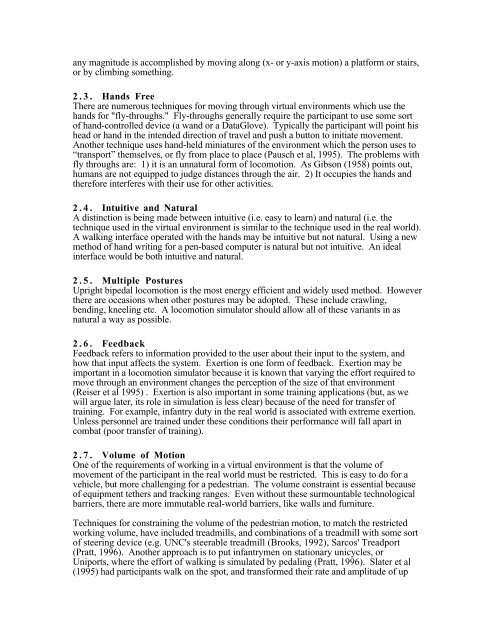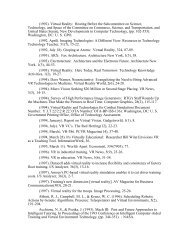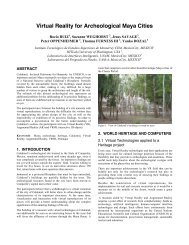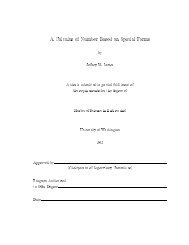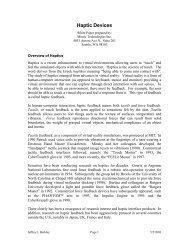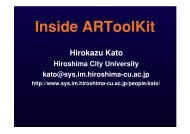The Virtual Motion Controller - Human Interface Technology ...
The Virtual Motion Controller - Human Interface Technology ...
The Virtual Motion Controller - Human Interface Technology ...
Create successful ePaper yourself
Turn your PDF publications into a flip-book with our unique Google optimized e-Paper software.
any magnitude is accomplished by moving along (x- or y-axis motion) a platform or stairs,<br />
or by climbing something.<br />
2.3. Hands Free<br />
<strong>The</strong>re are numerous techniques for moving through virtual environments which use the<br />
hands for "fly-throughs." Fly-throughs generally require the participant to use some sort<br />
of hand-controlled device (a wand or a DataGlove). Typically the participant will point his<br />
head or hand in the intended direction of travel and push a button to initiate movement.<br />
Another technique uses hand-held miniatures of the environment which the person uses to<br />
“transport” themselves, or fly from place to place (Pausch et al, 1995). <strong>The</strong> problems with<br />
fly throughs are: 1) it is an unnatural form of locomotion. As Gibson (1958) points out,<br />
humans are not equipped to judge distances through the air. 2) It occupies the hands and<br />
therefore interferes with their use for other activities.<br />
2.4. Intuitive and Natural<br />
A distinction is being made between intuitive (i.e. easy to learn) and natural (i.e. the<br />
technique used in the virtual environment is similar to the technique used in the real world).<br />
A walking interface operated with the hands may be intuitive but not natural. Using a new<br />
method of hand writing for a pen-based computer is natural but not intuitive. An ideal<br />
interface would be both intuitive and natural.<br />
2.5. Multiple Postures<br />
Upright bipedal locomotion is the most energy efficient and widely used method. However<br />
there are occasions when other postures may be adopted. <strong>The</strong>se include crawling,<br />
bending, kneeling etc. A locomotion simulator should allow all of these variants in as<br />
natural a way as possible.<br />
2.6. Feedback<br />
Feedback refers to information provided to the user about their input to the system, and<br />
how that input affects the system. Exertion is one form of feedback. Exertion may be<br />
important in a locomotion simulator because it is known that varying the effort required to<br />
move through an environment changes the perception of the size of that environment<br />
(Reiser et al 1995) . Exertion is also important in some training applications (but, as we<br />
will argue later, its role in simulation is less clear) because of the need for transfer of<br />
training. For example, infantry duty in the real world is associated with extreme exertion.<br />
Unless personnel are trained under these conditions their performance will fall apart in<br />
combat (poor transfer of training).<br />
2.7. Volume of <strong>Motion</strong><br />
One of the requirements of working in a virtual environment is that the volume of<br />
movement of the participant in the real world must be restricted. This is easy to do for a<br />
vehicle, but more challenging for a pedestrian. <strong>The</strong> volume constraint is essential because<br />
of equipment tethers and tracking ranges. Even without these surmountable technological<br />
barriers, there are more immutable real-world barriers, like walls and furniture.<br />
Techniques for constraining the volume of the pedestrian motion, to match the restricted<br />
working volume, have included treadmills, and combinations of a treadmill with some sort<br />
of steering device (e.g. UNC's steerable treadmill (Brooks, 1992), Sarcos' Treadport<br />
(Pratt, 1996). Another approach is to put infantrymen on stationary unicycles, or<br />
Uniports, where the effort of walking is simulated by pedaling (Pratt, 1996). Slater et al<br />
(1995) had participants walk on the spot, and transformed their rate and amplitude of up


